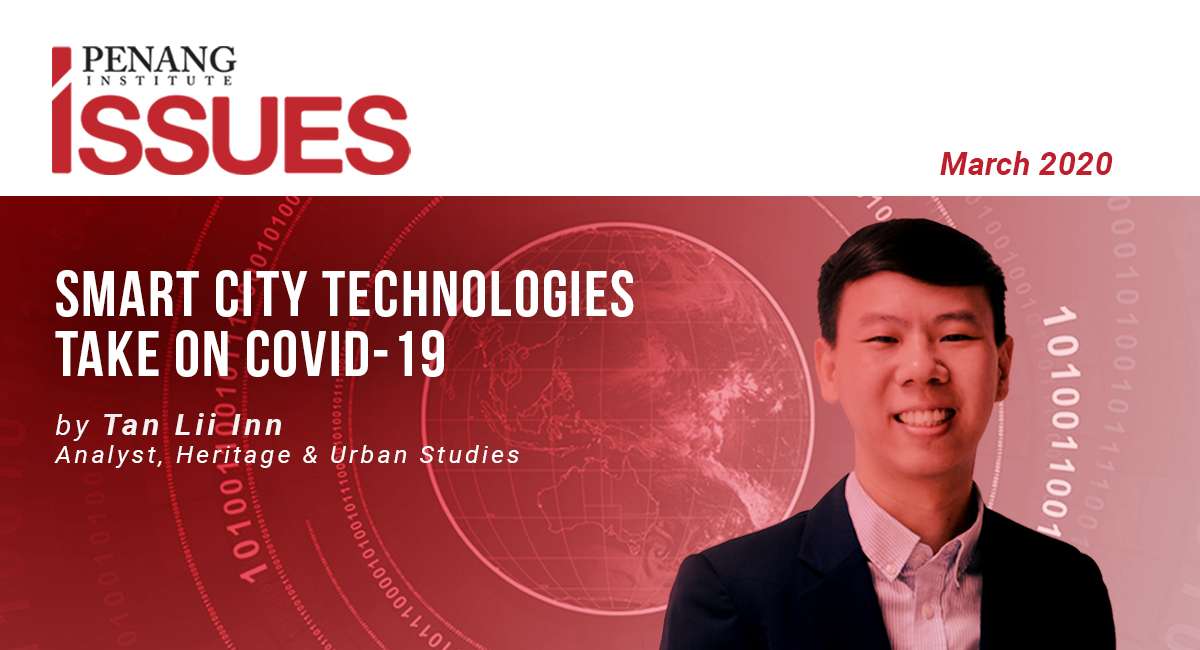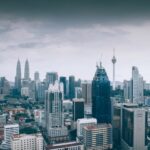Executive Summary
- AI-equipped big data and predictive analytics demonstrably play a vital role during an epidemic outbreak
- Through smart city technologies, policy makers are able to enhance urban governance through informed decisions and responsive policies. This has amply been proven by China and South Korea during the ongoing Covid-19 outbreak
- In light of this, Penang’s Smart State vision and direction should be revisited, and the fundamental infrastructure laid for the deployment of certain technologies and for access to analytics
- The functions of a smart city are closely tied to local needs and resource availability, and thus it is important to identify what are readily available in the local context, to possible pragmatic alternatives
Introduction
A cluster of “unusual pneumonia” cases emerging around a market in China’s Wuhan was spotted and flagged by BlueDot, which is an artificial intelligence (AI) system, after midnight on 30th December 2019[1]. Nine days later, on 9th January 2020, a statement on “cluster of pneumonia cases in Wuhan” was issued by the World Health Organization (WHO).[2] The disease was ascribed by the WHO as “Covid-19” on 11th February 2020[3] and categorized as a “pandemic” on 11th March 2020, after more than 118,00 cases had occurred in 114 countries, making it the first pandemic sparked by a coronavirus[4].
Launched in 2014, the Toronto-based BlueDot consists of physicians, veterinarians, epidemiologists, data scientists, and software developers[5], utilizing natural language processing and optimizing its machine learning to process vast amounts of information every 15 minutes and 24 hours a day, culling statements from official public health organizations, digital media, global airline ticketing data, livestock health report, and population demographics.[6] By employing the AI technology, BlueDot also predicted the spread of the virus from Wuhan to Bangkok, Taipei, Singapore, Tokyo, and Hong Kong.[7]
BlueDot “wasn’t alone”. HealthMap, an automated service at Boston Children’s Hospital, and Metabiota, which is based in San Francisco, were among others that had caught the initial signs of Covid-19.[8] What these alerts demonstrate is that the concept of “Smart City”, which deploys smart technologies such as AI and Big Data, does actually play a vital role in an epidemic outbreak. Scholars have pointed out that AI “allows for better urban governance as policy makers can make informed decisions and formulate adequate and responsive policies” that actually help in facilitating “the better provision of liveability dimensions; through cleanliness, health and conducive environments for people to live and work”.[9]
Other than being employed for predictive analytics, AI can also be utilised to support diagnosis and treatment, and to assist online education for minimizing disruption to people’s lives during an outbreak.[10] The rich array of technological products hosted by a smart city, including thermal cameras and Internet of Things (IOT) sensors, allow for early discussions and efforts on the management of any future outbreaks and for improving the health fabric of the city.[11]
The Experience of China
Since the introduction of its “Next-Generation Artificial Intelligence Development Plan” in July 2017[12], China has been aiming at excelling as a global leader in the fields of innovation and technology, particularly in the development of AI. The country has already taken a leading position in the supply of AI after the United States.[13] AI start-ups in China have received much higher rates of investment, at 296% more than global average.[14] In addition, China has also the highest rate in adopting AI and piloting AI in the world.[15]
Various technologies have been utilized by China to fight against Covid-19. Being the country that has established the world’s most advanced system for mass surveillance[16], China is able to optimize its surveillance system to enhance public security and the livelihood of its people.
For instance, the combination of infrared cameras and the facial recognition system is able to detect any individual with high temperature and whether or not the person is wearing a mask.[17] Generally, the efficacy of the facial recognition system is reduced to as low as 30% when a mask is used[18]. However, an upgraded version that China has developed has shown itself able to identify masked people with the recognition rate of around 95 percent.[19]
On the other hand, robots equipped with AI have been developed in China to reduce the potential risk of exposing authority to Covid-19 while conducting manual measurement of body temperature. Powered with 5G and equipped with five high-resolution cameras and infrared thermometers, these self-driving robots are able to scan the temperature of 10 people simultaneously within the radius of five metres, and the authority will be alerted by these robots when a person with fever and/or without a mask has been detected.[20]
The improved facial-recognition system allows better tracing and tracking of movement of a Covid-19 person under investigation. The AI-equipped robots not only save on manpower, but also help reduce risks to enforcers on duty, particularly in lowering cross-infection.
The WHO has recognized the successful application of big data and AI by China for Covid-19 preparedness, readiness and response, and has acknowledged the role of cutting-edge technologies in enabling the implementation of China’s containment measures.[21] China’s experience has been viewed as “the first time AI has been used so extensively to combat an epidemic” and the spread of the Covid-19 “would have been much quicker and more devastating” without AI.[22]
The Experience of South Korea
South Korea currently leads the world as the most innovative economy after Germany.[23] It is also one of the world’s top ten economies in terms of both “innovation inputs” and “quality of innovation”, mainly due to its strengths in research and development (R&D), information and communication technologies (ICTs), and e-participation.[24]
Multiple technologies have been deployed to curb the spread of Covid-19 in South Korea. The disease management system in the country was reorganised after the outbreak of the Middle East Respiratory Syndrome (MERS) in 2015, leading to the quick production of test kits supported by a large-capacity healthcare system and a sophisticated biotech industry.[25]
To date, the testing capacity of 20,000 people per day at 633 sites, including drive-thru centres and even phone booths, has already been carried out in South Korea.[26] The people are tested without leaving their cars at 50 drive-through stations where a questionnaire, a remote temperature scan, and a throat swab are conducted for about 10 minutes and the test results are usually available within hours.[27]Early testing is essential for timely responsive action during an outbreak.
A combination of “bureaucratic acumen” and “technological prowess” has been employed by South Korea to secure public participation through openness and transparency, and to develop effective means of response via creativity and cutting-edge technologies.[28] The government is authorised with enacted legislation to collect essential personal data from infected individuals for the purpose of reconstructing their recent whereabouts.[29] Known or potential patients are tracked in South Korea through their cashless transactions, including credit and debit cards, and also through the location of their mobile phones.[30] In addition, data-mining of CCTV footage has been utilised to backtrack the movements of infected individuals.[31]
The government has also developed a smartphone app known as “Self-quarantine Safety Protection” that is capable via GPS tracking, of monitoring citizens, particularly those required to be on self-quarantine, and that allows them to report their symptoms and status updates.[32] South Korea has also optimized platforms such as television broadcasts, subway station announcements, and smartphones alerts to provide endless reminders about wearing face masks, pointers on social distancing, and daily transmission data.[33]
With these efforts, South Korea has particularly been pointed out that “there are encouraging signs that the outbreak is stabilizing and that authorities are making progress in flattening the curve”[34]. “Flattening the curve” is essential during the outbreak as it allows relevant authorities or agencies to “gain invaluable time to respond to the crisis”.[35] The WHO has not only acknowledged the efficacy of the “exhaustive contact tracing and testing” employed by South Korea, but also urged countries to apply the lessons learned from South Korea and adapt them to the local context.[36]
Moving Forward for Penang
The improved facial recognition surveillance system and the AI-equipped robots are unlikely to be readily and instantly implementable in countries where the concept of smart city and the functions of smart governance are not in place. In Malaysia, the fundamental infrastructure to enable smart governance is still being developed, thus the AI-equipped smart surveillance system might not be an instantly available option for monitoring and curbing Covid-19.
Be that as it may, Malaysia should be able to explore and enhance via the lens of smart governance how the situation can be improved. The Penang State Government, for example, could look into effective ways of handling Covid-19 with existing available resources.
It should revisit its Smart State vision and direction, and study the fundamental infrastructure that must be laid for the deployment of certain technologies and for access to analytics for quick and precise decision making. The capacity of Penang’s Intelligent Operation Centre (IOC) can be enhanced to collect, maintain, and process data ranging from personalised information to travel behaviour as well as business profiling and operation behaviours. A proper inventory of Penang’s current smart infrastructure and capacity must be catalogued too for upgrade prioritisation purposes. All this is vital information for the IOC to understand the pattern of the people’s activities. By employing big data analytics, areas affected with Covid-19 can be displayed on the system and be closely monitored. Some probable outbreak locations can be geolocated through analysing the patterns of population movement and where virus cases were previously spreading.
The suggested system can be developed and achieved through the State Government’s experience in implementing the “Crush Aedes Totally” (CAT) initiative that carries functions identical to the proposed system. In developing this system, authorities such as the State Health Department and local authority, should be able to advance action and be responsive in real-time.
Further down the road, the proposed system could be integrated with the CAT and upgraded into an advanced AI-equipped system capable of identifying disease cases and forecasting outbreaks of other diseases, such as influenza, dengue, Hand, Foot, and Mouth Disease (HFMD), Nipah virus, Poliomyelitis, Severe Acute Respiratory Syndrome (SARS), etc. With more resources, the system could be further upgraded to having the ability to recreate the routes of confirmed patients—by learning from the South Korea’s experience, such as in the using of surveillance camera footage, cashless transactions, and the geolocation of mobile phones.
Unlike South Korea, Malaysia has neither provisions nor regulations that allow either federal, state or local governments to collect personal data, even for the purpose of enhancing public security. Alternatively, Penang State Government may start preparing itself for making advancement in civic engagement to encourage citizens to voluntarily share selected information with the authority, and with the guarantee that any shared information will not be misused or disclosed to third parties.
To cultivate related talents and technology locally, the existing Penang i4.0 Seed Fund could be further expanded by the State Government via Public-Private-Professional-People Partnerships. Open sharing platforms should also be further promoted by the State Government. This will contribute to the development of emerging cutting-edge technologies, and foster research on relevant hardware and software.
These proposed ideas hold the potential to accelerate the State’s vision of Penang2030 that aims to make Penang a “Family-focused Green and Smart State that Inspires the Nation”. The utilization of smart city technologies in governance not only assists the State Government in increasing liveability (Theme A of Penang2030), it also shows the will of the State Government in improving its resilience and urban services (Theme D of Penang2030). Encouraging citizens to voluntarily share selected information will further strengthen civic participation (Theme C of Penang2030) in decision-making by channelling information to relevant government instances.
Concluding Remarks
Smart city has great relevance in a global pandemic. Briefly, there are at least five areas that smart city technologies can contribute to. These include, but are not limited to, the use of: (i) AI to identify, track, and forecast outbreaks through big data analytics; (ii) AI to enhance public security via improved facial-recognition and infrared technologies; (iii) Drones or smart robots to sterilize, deliver supplies, and assist surveillance; (iv) AI to help study the virus, diagnose the virus, and develop potential medical treatments; and (v) Emerging platforms, including smart apps and AI-powered chatbots, to facilitate virtual communication during periods of reduced human-to-human physical contact.
However, a lot of data, time, and resources are needed for leveraging the advantages of smart city technologies. Thus, the function of smart city must closely tie in with local needs and the resources availability. In addition, the idea of smart city varies from city to city and therefore it is important to look into what are readily and instantly available in a local context. It is also essential that we relate the idea to possible pragmatic alternatives—speed and time matter greatly during an outbreak.
Of course, even if smart city technologies are readily available, they amount to very little if the public do not practise good personal hygiene, do not avoid human-to-human physical contact as much as possible, and/or do not share with the authority their travel history and close contacts. The role of smart city during an outbreak is further enhanced and “empowered” when the people themselves also demonstrate well-grounded qualities and act responsibly not only for the benefit of the local, but also for all mankind.
References
Advantech. (2020, March 16). Smart 5G patrol robots equipped with Advantech’s MIC-770 Edge Computer deploye3d to fight Coronavirus. Advantech. Retrieved from https://www.advantech.com.my/resources/news/smart-5g-patrol-robots-equipped-with-advantech’s-mic-770-edge-comp uter-deployed-to-fight-coronavirus
AFP. (2020, February 19). How a Canadian startup used AI to tack China virus. The Star. Retrieved from https://www.thestar.com.my/tech/tech-news/2020/02/20/how-a-canadian-startup-used-ai-to- track-china-virus
Allam, Z., & Dhunny, Z. A. (2019). On big data, artificial intelligence and smart cities. Cities, 89,
80-91.
Allam, Z., & Jones, D. S. (2020). On the Coronavirus (COVID-19) outbreak and the smart city network: Universal data sharing standards coupled with artificial intelligence (AI) to benefit urban health monitoring and management. Healthcare, 8(1), 46.
Castro, D., McLaughlin, M., & Chivot, E. (2019). Who is winning the AI race: China, the EU or the
United States? Center for Data Innovation.
Chen, S. (2020, February 13). Covid-19: How the coronavirus outbreak is testing China’s vaunted surveillance technology. The Star. Retrieved from https://www.thestar.com.my/tech/tech-news
/2020/02/13/covid-19-how-the-coronavirus-outbreak-is-testing-chinas-vaunted-surveillance-technol ogy
Chun, A. (2020, March 18). In a time of coronavirus, China’s investment in AI is paying off in a big way. South China Morning Post. Retrieved from https://www.scmp.com/comment/opinion/article/3075553/time-coronavirus-chinas-investment-ai-paying-big-way
Cornell University, INSEAD, & World Intellectual Property Organization (WIPO). (2019). The Global Innovation Index 2019: Creating healthy lives – The future of medical innovation. Cornell University, INSEAD, & World Intellectual Property Organization (WIPO)
Fisher, M., & Choe, S-H. (2020, March 23). How South Korea flattened the curve. The New York Times. Retrieved from https://www.nytimes.com/2020/03/23/world/asia/coronavirus-south- korea-flatten-curve.html
Heaven, W. D. (2020, March 12). AI could help with the next pandemic – but not with this one. MIT Technology Review. Retrieved from https://www.technologyreview.com/s/615351/ai-could-help
-with-the-next-pandemicbut-not-with-this-one/
Jamrisko, M., & Lu, W. (2020, January 18). Bloomberg Innovation Index: Germany breaks Korea’s six-year streak as most innovative nation. Bloomberg. Retrieved from https://www. bloomberg.com/news/articles/2020-01-18/germany-breaks-korea-s-six-year-streak-as-most-innovati ve-nation
Jung, W. S. (2020, March 20). Commentary: South Korea succeeded in controlling COVID-19 panic buying, thanks to tracking and surveillance. Channel NewsAsia. Retrieved from https://www. channelnewsasia.com/news/commentary/covid-19-coronavirus-south-korea-cases-test-data-surveilla nce-12559252
Kim, M. S. (2020, March 6). South Korea is watching quarantined citizens with a smartphone app.
MIT Technology Review. Retrieved from https://www.technologyreview.com/s/615329/coronavirus-south-korea-smartphone-app-quarantine/
McCarthy, N. (2020, March 11). Has South Korea stabilized its COVID-19 outbreak? [Infographic].
Forbes. Retrieved from https://www.forbes.com/sites/niallmccarthy/2020/03/11/has-south-korea-stabilized-its-covid-19-outbreak-infographic/#43741d64686f
McKinsey Global Institute. (2019). China and the world: Inside the dynamics of a changing relationship. McKinsey Global Institute.
McQueen, M. (2020, March 16). Why ‘flattering the curve’ is so important in the fight against coronavirus. World Economic Forum. Retrieved from https://www.weforum.org/agenda/2020/03/coronavirus-control-measures/
Millard, N. (2020, March 12). South Korea turns to tech to take on Covid-19. Asia Times. Retrieved from https://asiatimes.com/2020/03/south-korea-turns-to-tech-to-take-on-covid-19/
Moon, G. (2020, March 24). This is how South Korea flattened its coronavirus curve. NBC News. Retrieved from https://www.nbcnews.com/news/world/how-south-korea-flattened-its-coronavirus
-curve-n1167376
Normile, D. (2020, March 17). Coronavirus cases have dropped sharply in South Korea. What’s the secret to its success? Science. Retrieved from https://www.sciencemag.org/news/2020/03/coronavirus-cases-have-dropped-sharply-south-korea-whats-secret-its-success
Penang2030 Unit. (2019). Penang2030: A Family-focused Green and Smart State that Inspires the
Nation. Penang: Penang2030 Unit.
Pollard, M. (2020, March 9). Even mask-wearers can be ID’d, China facial recognition firm says. Reuters. Retrieved from https://www.reuters.com/article/us-health-coronavirus-facial-recognition/ even-mask-wearers-can-be-idd-china-facial-recognition-firm-says-idUSKBN20W0WL
Stanford Institute for Human-Centred Artificial Intelligence. (2019). Artificial Intelligence Index
2019 Annual Report. California: Stanford Institute for Human-Centred Artificial Intelligence, Stanford University.
Stieg, C. (2020, March 3). How this Canadian start-up spotted coronavirus before everyone else knew about it. CNBC Make It. Retrieved from https://www.cnbc.com/2020/03/03/bluedot- used-artificial-intelligence-to-predict-coronavirus-spread.html
The State Council of China. (2017). The Next-Generation Artificial Intelligence Development Plan. The State Council of China. Retrieved from http://www.gov.cn/zhengce/content/2017-07/20/content_5211996.htm
World Health Organization. (2020, January 9). WHO statement regarding cluster of pneumonia cases in Wuhan, China. World Health Organization. Retrieved from https://www.who.int/china/ news/detail/09-01-2020-who-statement-regarding-cluster-of-pneumonia-cases-in-wuhan-china
World Health Organization. (2020, February 11). WHO Director-General’s remarks at the media briefing on 2019-nCoV on 11 February 2020. World Health Organization. Retrieved from https://www.who.int/dg/speeches/detail/who-director-general-s-remarks-at-the-media-briefing-on-2
019-ncov-on-11-february-2020
World Health Organization. (2020, February 16-24). Report of the WHO-China Joint Mission on Coronavirus Disease 2019 (COVID-19). World Health Organization. Retrieved from https://www.who.int/publications-detail/report-of-the-who-china-joint-mission-on-coronavirus-disea se-2019-(covid-19)
World Health Organization. (2020, March 11). WHO Director-General’s opening remarks at the media briefing on COVID-19 – 11 March 2020. World Health Organization. Retrieved from
https://www.who.int/dg/speeches/detail/who-director-general-s-opening-remarks-at-the-media-briefi ng-on-covid-19—11-march-2020
World Health Organization. (2020, March 18). WHO Director-General’s opening remarks at the media briefing on COVID-19 – 18 March 2020. World Health Organization. Retrieved from
https://www.who.int/dg/speeches/detail/who-director-general-s-opening-remarks-at-the-media-briefi ng-on-covid-19—18-march-2020
Xu, C., Luo, X., Yu, C., & Cao, S. (2020). The 2019-nCoV epidemic control strategies and future challenges of building healthy smart cities. Indoor and Built Environment, 29(5), 1-6.
[1] Stieg, C. (2020, March 3).
[2] World Health Organization. (2020, January 9).
[3] World Health Organization. (2020, February 11).
[4] World Health Organization. (2020, March 11).
[5] AFP. (2020, February 19).
[6] Stieg, C. (2020, March 3).
[7] AFP. (2020, February 19).
[8] Heaven, W. D. (2020, March 12).
[9] Allam, Z., & Dhunny, Z. A. (2019).
[10] Xu, C., Luo, X., Yu, C., & Cao, S. (2020).
[11] Allam, Z. & Jones, D. S. (2020).
[12] The State Council of China. (2017).
[13] McKinsey Global Institute. (2019).
[14] Stanford Institute for Human-Centred Artificial Intelligence. (2019).
[15] Castro, D., McLaughlin, M., & Chivot, E. (2019).
[16] Chen, S. (2020, February 13).
[17] Chun, A. (2020, March 18).
[18] Chen, S. (2020, February 13).
[19] Pollard, M. (2020, March 4).
[20] Advantech. (2020, March 16).
[21] World Health Organization. (2020, February 16-24).
[22] Chun, A. (2020, March 18).
[23] Jamrisko, M., & Lu, W. (2020, January 18).
[24] Cornell University, INSEAD, & World Intellectual Property Organization (WIPO). (2019).
[25] Jung, W. S. (2020, March 20).
[26] Moon, G. (2020, March 24).
[27] Fisher, M., & Choe, S-H. (2020, March 23).
[28] Millard, N. (2020, March 12).
[29] Normile, D. (2020, March 17).
[30] Jung, W. S. (2020, March 20).
[31] Millard, N. (2020, March 12).
[32] Kim, M. S. (2020, March 6).
[33] Fisher, M., & Choe, S-H. (2020, March 23).
[34] McCarthy, N. (2020, March 11).
[35] McQueen, M. (2020, March 16).
[36] World Health Organization. (2020, March 18).
Managing Editor: Ooi Kee Beng, Editorial Team: Alexander Fernandez and Nur Fitriah (designer)
You might also like:
![An Inquisition into Malaysia’s PADU Subsidy Targeting, and Beyond]()
An Inquisition into Malaysia’s PADU Subsidy Targeting, and Beyond
![Heritage Tourism in George Town: A Complicated and Always Controversial Issue]()
Heritage Tourism in George Town: A Complicated and Always Controversial Issue
![Making Food Hawking in Penang Sustainable]()
Making Food Hawking in Penang Sustainable
![The Covid-19 Disruption Highlights the Neglected Nature of Arts and Culture Sector in Malaysia]()
The Covid-19 Disruption Highlights the Neglected Nature of Arts and Culture Sector in Malaysia
![Cashierless Technology at Grocery Stores: An Imminent Step towards Safer and Smarter Shopping in Pen...]()
Cashierless Technology at Grocery Stores: An Imminent Step towards Safer and Smarter Shopping in Pen...







